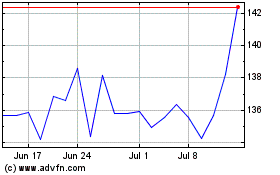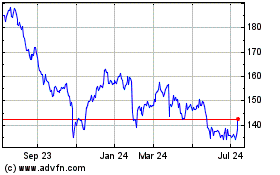By Laura Stevens
Amazon.com Inc. wants its warehouse employees to get to work --
fast.
To prepare for the flood of holiday orders already under way,
the retail giant has been using technology ranging from touch
screens to robots to shrink the time it takes to train new hires to
as little as two days, compared with up to six weeks for a
conventional warehouse job.
The shorter training period saves Amazon money, and could give
the company room to offer higher wages as it seeks to expand its
workforce about 40% by adding 120,000 temporary workers at its U.S.
warehouses for the peak sales season that runs roughly from
November through December.
Complicating that task is the tight labor market, which is
forcing Amazon to slug it out with rivals like Wal-Mart Stores Inc.
and package-delivery companies like United Parcel Service Inc. as
they all try to staff up for the holidays.
"They're fighting over the same labor pool," said Tom Bianculli,
chief technology officer at Zebra Technologies Corp., which works
with retailers.
The outcome is particularly critical for Amazon, which owns one
of the world's biggest networks of warehouses and needs a host of
seasonal workers to keep them chugging along.
Rapid turnover, along with low unemployment and recent pay gains
for the nation's lowest-wage workers, have forced Amazon to get
nimbler to attract seasonal help, in part by making training fast,
easy and flexible for its recruits, who typically make more than
minimum wage. At Amazon and other warehouse operators, these types
of workers can stay on from six weeks to three months into the New
Year to drive forklifts, pick orders or deliver boxes.
Amazon also is quickly increasing the number of full-time staff
it employs. It retained about 14% of its seasonal hires last year,
in part by offering perks such as prepaid tuition for warehouse
workers who remain on the job for at least a year.
Though worker training is a year-round challenge for Amazon, one
of its priorities for the fourth quarter is, "what is the
technology that can set an employee up as efficiently and as safely
as possible?" said John Olsen, Amazon's vice president of human
resources, world-wide operations. Amazon says its holiday sales
this season could increase as much as 27% from last year to a
high-end range of $45.5 billion.
This year alone, Amazon has built 26 new warehouses, bringing
its world-wide total to 149. Wal-Mart, meanwhile, has added 10 new
e-commerce hubs over roughly two years to its dozens of smaller
e-commerce and store warehouses, along with 80 stores that ship
directly to consumers. Other traditional retailers and smaller
e-commerce companies might have just three or four U.S. warehouses
targeting major population centers
Amazon's newest facilities incorporate the most automation,
using screens, robots, scanners and other technology to quickly get
workers up to speed, according to Mr. Olsen. Amazon trainees get
hands-on training as early as their first day on the job, which he
said has proven to be a huge advantage in getting them up to speed.
On the warehouse floor, they learn how to pack up shipments,
coached by a screen that tells them which box size to use and
automatically spits out a piece of tape to fit it.
In conventional warehouses, by contrast, new employees typically
spend their first days in classroom training, say supply-chain
experts.
The difference may give Amazon an edge. "Employee turnover
becomes a little less of a problem when the learning curve is
short," said Brian Devine, senior vice president at logistics
staffing firm ProLogistix.
Small changes can make a big difference in a warehouse's
efficiency. Delivery giant UPS, for example, has introduced
color-coded scanning technology in some locations that eliminates
the need for workers to memorize more than 120 ZIP Codes.
Because Amazon's warehouses are fairly uniform, the company can
introduce the same training programs across its buildings and
multiply any efficiency gains, said Steve Osburn, a warehousing
expert with retail consulting firm Kurt Salmon.
A typical Amazon warehouse has loading docks for trucks to pull
up to on either side to keep merchandise moving through. Two shifts
keep operations running nearly 24 hours a day as the holidays
approach, with groups of employees keeping goods moving along an
average 8-mile maze of conveyor belts.
The newest warehouses, filled with robots, require a higher head
count than older sites because the greater efficiency allows them
to process even more orders, a task that still requires humans.
At one of Amazon's fulfillment centers in DuPont, Wash., a large
yellow robot arm moves pallets of items to the second story of the
warehouse as new employees attend safety school on the mezzanine,
learning techniques such as how to lift packages without back
strain.
Orange, pallet-sized robots that move faster than humans carry
shelves full of merchandise to stations where workers can reach
them. Screens show the workers what the desired item looks like and
where it is placed so they can pluck it off the shelf quickly and
accurately.
That's a far cry from a conventional warehouse, where workers
have to memorize -- often by location number -- where items are
stored, and then go looking for them when needed.
After taking an item off a robot-carried shelf at one of
Amazon's new warehouses, the worker scans it, and a light flashes
to show which container to place it in to get it ready for
shipping.
"The technology works to walk you through the steps," said
Amazon's Mr. Olsen. "It automates almost everything."
Ngcebo Sibiya, 21 years old, spent a few days last December
working the night shift as a seasonal worker at an Amazon warehouse
in Milton Keynes, England. He said the training was simple and
effective. "They demonstrated our job, how it's done," he said,
along with providing safety training on things like how to safely
cross a floor with moving forklifts. He said he got hands-on
training in how to package a shipment, and was ready to get to work
after a day. "It was pretty easy, just packing packages...decent
pay too," he added. He said he quit because the job made him late
for school.
Write to Laura Stevens at laura.stevens@wsj.com
(END) Dow Jones Newswires
November 28, 2016 05:44 ET (10:44 GMT)
Copyright (c) 2016 Dow Jones & Company, Inc.
United Parcel Service (NYSE:UPS)
Historical Stock Chart
From Mar 2024 to Apr 2024

United Parcel Service (NYSE:UPS)
Historical Stock Chart
From Apr 2023 to Apr 2024
